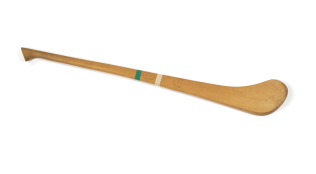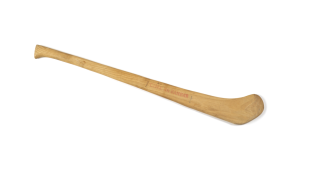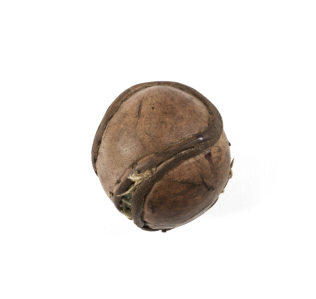Hurling - Objects Associated With Our National Sport









Hurling is one of the fastest field games in the world and in the National Museum we have the earliest artefacts associated with our national game, a hurley and balls of cow hair dating to c.1500AD (the earliest of the balls dating to c.1192AD). [Fig. 2.]
The game is much older with references to hurling in early Irish manuscripts and laws. The surviving manuscripts, such as the recensions of the Táin Bó Cúailnge may date to the twelfth century but are the writing of much earlier oral tales associated with the first century.
Hurling is a game that demands superb skill, lightning speed and split-second reactions which has become even faster than ever before as fitness, training and skills improve.
‘The Clash of the Ash’
The game that was standardised by the GAA at the end of the nineteenth century is considered to be an amalgamation of two different games of hurling that existed in Ireland. It combined a ground-based driving game, played with a narrow stick, similar to the Scottish game of shinty, and a game played with a wider ended stick that allowed for catching and travelling with the ball.
‘The clash of the ash’ is an expression illustrating the resilience the wood that endures a battering in any game of hurling. Hurleys are traditionally made of Irish ash, but more often nowadays, imported wood. Holland, England, Denmark and Sweden are the most common sources of timber for the uniquely Irish game. The wood for a hurley has to be durable and the base of an ash tree created an ideal strong curved piece of wood. Strangely, the earliest Museum hurling stick was not made of ash but of another durable wood, alder. [Fig. 3.]
In the Irish Folklife collection we have a large collection of hurleys and the older ones are thinner in shape at the base or ‘bas’ as it is also called. [Fig. 4.]
Making a Hurley
The making of the hurley involves a pattern and then a copying lathe cuts a rough shape out on several pieces of wood. Each stick is finished by hand with tools such as the band saw, spokeshave, planers and sanders. The length of the hurleys are based on the measurement of the hurler reaching the wrist bone of the standing player. The upper hand grip and metal bands near the end are individual to the craftsman and bespoke for particular players.
In the GAA Official Guide 2019 the only rule relating to hurling sticks is that ‘The bas of a hurley at its widest point shall not be more than 13cm’. Many makers have templates that are much larger and c.16cm is more favoured by players today. There is also a trend for shorter hurls allowing the ball to be closer to the hand and a move away from ground hurling.
Pallaskenry, Co. Limerick.
Fig.5. This Limerick hurley with bands of green and white tape on the shaft was donated in 1973 by Paddy Daly of Pallaskenry, Co. Limerick. ‘’P. Daly’’ is ink-stamped on both sides of the shaft. Paddy was a hurley maker who started hand-crafting hurleys in the 1930s. His son DJ, and grandson Pádraig, still run the family business of Daly’s Champion Hurleys.
F1973.125.
Hurley – Cahir, Co. Tipperary.
Fig. 6. This hurley was donated in 1972 by J.J. O’Brien of Cahir, Co. Tipperary and has his name stamped on both sides of the shaft. John Joe O’Brien started making hurleys in Cahir in the 1930s. He made hurleys for the famous Tipperary players, Michael Byrne, better known as “the Rattler” Byrne and Nicky English. The tradition of hurley making continued through his sons Ger and Anthony O’Brien. Now his grandson Johnny (Johnny B from The 2 Johnnies) continues to make hurleys in the same workshop on the Tipperary Road in Cahir. The green stamp with the drawing of the hurler is no longer used as each O’Brien maker has since had their own individual stamps.
F1972.131.
Hurley – Kilkenny, Co. Kilkenny.
Fig. 7. Patrick Oliver Walsh gifted this hurley to the National Museum of Ireland in 1972. It is varnished and repairs have been made to the bas with the addition of two metal bands.
The owner of this hurley was better known as the legendary goalkeeper, Ollie Walsh who was born in Thomastown and played for his local GAA club. He was on the Kilkenny County team from 1956-1972 and lived in Fatima Place, Kilkenny. In 1967, he was awarded Texaco Hurler of the Year, the first time it ever went to a goalkeeper. He was also manager of the senior Kilkenny team in the first half of the nineties.
F1972.128.
Hurley – Cork City, Co, Cork.
Fig. 8. This hurley was given to the National Museum in 1973 by Séan Ó Laoire of Ciste na Banban Teo, a company based in Parnell Place, Cork City.
It supplied hurling sticks for the GAA and Cork players. The company, supported by the GAA managed fundraising pools and interest-free loans for all GAA clubs to avail of money for the improvement of their ground facilities.
All sizes of hurleys were donated including one of the type use by the Cork Senior team at that time. This one is a juvenile hurley for 6-8 year olds and has Ciste na Banban stamped in red on each side. It is 75cm long and 8.5cm at the widest point of the bas.
It also had a label attached that read, ‘The Central Council for the GAA recognise the following hurleys for juveniles 30’’ used by age group 6-8 years, 32’’ for 9-11 year olds, 34’’ for 12-14 year olds and 36’’ for 15 and 16 year olds.’
F1973.45.
Hurling Ball – Roscommon Town, Co. Roscommon
Fig. 9. This sliotar was acquired in 1969 from Mrs. Teresa Monahan of Castle Street, Roscommon town. It is bound with two pieces of leather, both shaped like figures of eight. The leather pieces are stitched together with the edges projecting. The ball is burst in part revealing a wool and cork inner. The National Museum acquired material from the family saddlery that was based in the centre of the town. Saddles and all leather goods, including hurling balls were made by John Joe Monahan, Teresa’s husband.
The GAA Central Council now has recognised suppliers of approved sliotars with the GAA mark with less independent craftspeople making them. The inner cores can still be of cork and woollen thread but solid sphere of polymar are now often used for the centre of balls.
The modern balls have to be between 110 and 120 grams and rim heights and widths are also regulated so that the ball used does not give unfair advantage. The weight of this ball from Roscommon was only 75 grams.
F1969.544.
Further Reading
Clodagh Doyle (2016) Hair Hurling Balls: Review, Research and Scientific Investigations, Folk Life, 54:1, 3-31, DOI: 10.1080/04308778.2016.1159789
Paul Rouse (2018): The Hurlers: The First All-Ireland Championship and the Making of Modern
Hurling.
Aidan O’Sullivan (2016): Hurling and Camogie – searching for the early medieval origins of Ireland’s ancient games.
Alsakarneh, Amjad & Bryan, Keith & Cotterell, Matthew & Barrett, John. (2012). The influence of equipment variations on sliotar–hurley impact in the Irish game of hurling. Sports Engineering. 15. 10.1007/s12283-012-0098-3.
Mike Cronin, William Murphy and Paul Rouse (2009), The Gaelic Athletic Association, 1884–2009, Dublin: Irish Academic Press.







No Comments
Add a comment about this page